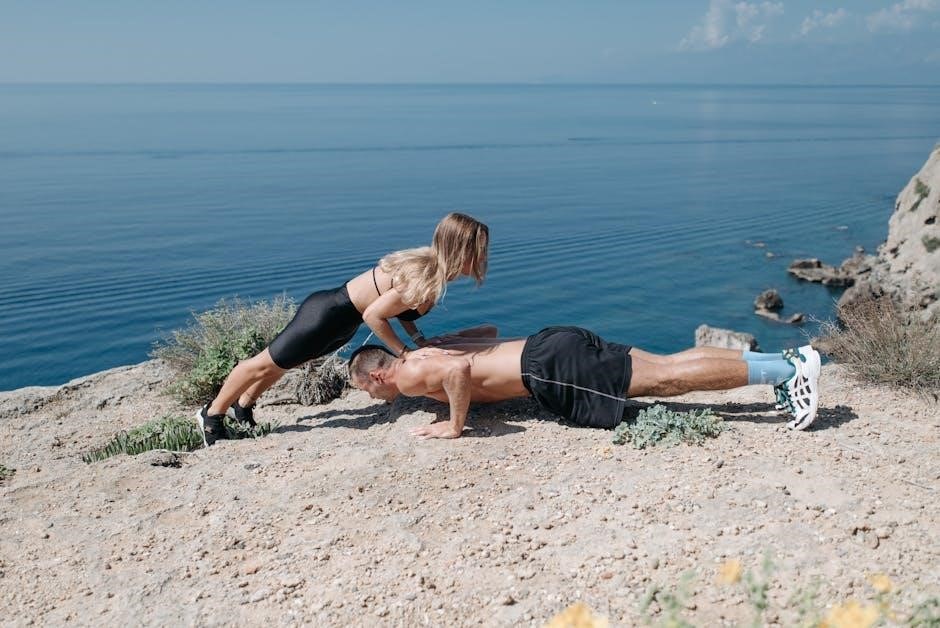Peroneal nerve entrapment involves compression of the nerve near the knee or ankle, causing pain, weakness, and sensory issues. Exercises, including stretching and strengthening routines, play a crucial role in managing symptoms and improving mobility. Utilizing a PDF guide provides structured, accessible plans to aid recovery effectively.
1.1 Definition and Overview
Peroneal nerve entrapment occurs when the common peroneal nerve is compressed, typically near the knee or fibula. This condition often leads to pain, weakness, and sensory deficits in the lower leg and foot. Exercises tailored for peroneal nerve entrapment focus on improving nerve mobility, reducing symptoms, and enhancing functional recovery. A well-structured PDF guide provides a comprehensive approach to these exercises, ensuring accessibility and adherence to rehabilitation protocols.
1;2 Importance of Exercises in Rehabilitation
Exercises are integral to peroneal nerve entrapment rehabilitation, aiming to restore nerve function, strength, and mobility. They enhance blood flow, reduce muscle atrophy, and improve sensory function. A structured PDF guide offers clear, progressive routines, ensuring consistency and efficacy. Regular practice, combined with professional guidance, accelerates recovery and prevents re-injury, making exercises a cornerstone of effective management and long-term symptom relief.
Causes and Risk Factors
Peroneal nerve entrapment often results from prolonged sitting, crossed legs, or repetitive activities. Tight footwear and certain positions can compress the nerve, leading to discomfort and limited mobility;
2.1 Common Causes of Peroneal Nerve Entrapment
Peroneal nerve entrapment commonly occurs due to prolonged periods of sitting with crossed legs or squatting, which compresses the nerve near the knee. Additionally, tight or poorly fitting footwear can exacerbate the condition. Repetitive activities, such as running or cycling, may also contribute to nerve irritation. In some cases, prolonged lying down with legs in a specific position can lead to nerve entrapment, causing discomfort and limited mobility in the affected leg or foot.
2.2 Activities That Increase Risk
Activities that involve repetitive knee flexion, such as cycling, running, or squatting, can increase the risk of peroneal nerve entrapment. Prolonged sitting with legs crossed or wearing tight footwear may also contribute. High-impact sports and jobs requiring frequent standing or walking on uneven surfaces can exacerbate the condition. Avoiding these activities or modifying them can help reduce the risk of nerve compression and related discomfort.
Symptoms of Peroneal Nerve Entrapment
Common symptoms include pain, numbness, and tingling along the outer lower leg and foot. Weakness in ankle movements and difficulty lifting the foot may also occur.
3.1 Common Symptoms
Common symptoms of peroneal nerve entrapment include pain, numbness, and tingling along the outer lower leg and top of the foot. Weakness in ankle movements, difficulty lifting the foot, and a “foot drop” gait may develop. Symptoms often worsen with activity and improve with rest. Some individuals may experience a burning sensation or sensitivity along the nerve path, especially during prolonged standing or walking.
3.2 Red Flags for Seeking Medical Help
Severe pain, sudden weakness, or inability to lift the foot are red flags requiring immediate medical attention. Persistent numbness, tingling, or muscle wasting in the lower leg or foot also warrant urgent evaluation. These symptoms may indicate nerve damage or compression that could lead to permanent dysfunction if untreated. Ignoring these signs can result in chronic issues, so prompt consultation with a healthcare professional is crucial for proper diagnosis and treatment.

Diagnosis and Assessment
Diagnosis involves clinical evaluation, including physical exams and patient history. Imaging like MRI or ultrasound may be used to confirm nerve entrapment and rule out other conditions.
4.1 Clinical Evaluation
Clinical evaluation begins with a thorough physical exam and patient history. Physicians assess tenderness, muscle weakness, and sensory changes. Specific tests, such as Tinel’s sign and manual muscle testing, are performed. Gait assessment may reveal foot drop or instability. Sensory exams check for numbness or tingling along the nerve path. These evaluations help identify compression points and severity, guiding further diagnostic steps and treatment planning for peroneal nerve entrapment.
4.2 Role of Imaging and Tests
Imaging and diagnostic tests are crucial for confirming peroneal nerve entrapment. MRI and ultrasound provide detailed images of the nerve and surrounding tissues, identifying compression points. Electromyography (EMG) and nerve conduction studies (NCS) assess nerve function and damage. These tests help differentiate entrapment from other conditions, ensuring an accurate diagnosis and informing treatment strategies. They are often used alongside clinical findings for comprehensive evaluation.

Treatment Options
Treatment for peroneal nerve entrapment includes conservative approaches like rest, physical therapy, and exercises. Surgery may be considered if conservative methods fail to relieve symptoms.
5.1 Conservative Management
Conservative management focuses on reducing nerve compression and restoring function. This includes rest, physical therapy, and exercises tailored to relieve pressure on the peroneal nerve. Pain management with NSAIDs may be recommended. Activity modification and orthotic devices can also help alleviate symptoms. Strengthening and stretching exercises are often prescribed to improve mobility and strength. This approach aims to avoid surgical intervention and promote natural recovery.
5.2 Surgical Intervention
Surgical intervention is considered when conservative treatments fail to relieve symptoms. The procedure typically involves decompressing the peroneal nerve by releasing tight tissues or structures causing compression. Surgery is often performed near the knee or fibula. Outcomes vary, with some patients achieving full recovery and others experiencing residual symptoms. Recovery may take several months, focusing on restoring nerve function and muscle strength through post-operative rehabilitation.

Role of Exercises in Recovery
Exercises play a crucial role in restoring function, reducing symptoms, and improving mobility in peroneal nerve entrapment. They enhance nerve glide, strength, and flexibility, aiding recovery.
6.1 Benefits of Exercise Therapy
Exercise therapy improves nerve function, reduces pain, and enhances mobility in peroneal nerve entrapment; It strengthens muscles, improves balance, and prevents atrophy. Regular exercises promote nerve glide, reducing compression and inflammation. They also enhance blood flow, aiding healing and restoring normal gait patterns. Consistent practice supports long-term recovery and reduces the risk of re-injury, making it a cornerstone of rehabilitation.
6.2 Types of Exercises
Exercises for peroneal nerve entrapment include stretching to improve flexibility and reduce tightness, strengthening to build muscle support, and functional mobility drills to enhance balance and coordination. Low-impact cardio, such as swimming or cycling, can also be beneficial. These exercises target the affected areas while promoting overall recovery and preventing further injury.
- Stretching exercises
- Strengthening exercises
- Functional mobility drills
- Low-impact cardio activities

Stretching Exercises
Stretching exercises focus on improving flexibility and reducing tension in the calves, hamstrings, and peroneal muscles. They are essential for relieving nerve compression and enhancing mobility.
- Target key muscle groups
- Hold stretches for 20-30 seconds
- Perform 2-3 times daily
7.1 Ankle Inversion Stretch
This stretch targets the peroneal muscles, helping to alleviate tension around the nerve. Sit on the floor with legs extended, loop a towel around the foot, and gently pull the foot inward. Hold for 20-30 seconds, then release. This exercise relieves nerve compression and improves ankle flexibility. Perform 2-3 times daily for optimal results.
- Focus on gentle, controlled movements
- Avoid bouncing or force
- Breathe deeply to enhance relaxation
7.2 Hamstring Stretch
Sit on the floor with legs extended, feet flexed. Loop a towel around the ball of one foot and gently pull toward your chest. Hold for 20-30 seconds, then switch sides. This stretch reduces lower limb muscle tightness, easing peroneal nerve tension. Perform 2-3 times daily for improved flexibility and comfort.
- Use a towel for better grip
- Keep back straight
- Breathe deeply
7.3 Towel-Assisted Stretch
Sit on the floor with legs extended. Place a towel under the ball of one foot and gently pull the towel toward you while keeping your knee straight. Hold for 15-20 seconds, then release. Repeat 2-3 times on each side. This stretch targets the calf and hamstring muscles, reducing tension around the peroneal nerve and improving ankle mobility.
- Keep the back straight
- Apply steady, controlled force
- Breathe deeply to relax
Strengthening Exercises
Strengthening exercises target the lower leg and foot muscles, improving stability and function. Use resistance bands, heel raises, and toe curls to build strength progressively.
8.1 Resistance Band Exercises
Resistance band exercises are effective for strengthening the peroneal muscles. Sit or stand with the band secured around the foot, pushing outward against the resistance. Focus on slow, controlled movements to avoid strain. Start with light resistance and gradually increase as strength improves. These exercises enhance ankle stability and muscle endurance, reducing the risk of further injury. They are ideal for home use and can be incorporated into daily routines for consistent progress.
8.2 Ankle Strengthening Techniques
Ankle strengthening techniques focus on improving peroneal muscle function. Weight-bearing exercises like heel raises and ankle circles target these muscles. Sit or stand, lifting the heel while keeping the knee straight. Gradually increase repetitions and resistance. These exercises enhance muscle endurance, improve balance, and reduce weakness. Consistent practice helps restore normal gait and reduce pain. Start with low-intensity movements and progress as strength improves.
8.4 Progression of Resistance Training
Progression of resistance training involves gradually increasing intensity. Start with light resistance bands or isometric exercises to avoid overloading. As strength improves, add weight or reps. Incorporate functional movements like step-ups or balance exercises. Avoid rapid progression to prevent re-injury. Monitor tolerance and adjust loads accordingly. Consistent, gradual progression enhances muscle stability and promotes long-term recovery.

Functional Mobility Exercises
Functional mobility exercises enhance movement, coordination, and gait, improving daily activities effectively and restoring normal movement patterns without straining the peroneal nerve.
9.1 Heel-To-Toe Walking
Heel-to-toe walking improves balance, gait, and coordination by simulating a normal walking pattern. Start with short distances, focusing on placing the heel directly in front of the toes. This exercise strengthens the muscles around the ankle and peroneal nerve, enhancing stability and reducing the risk of re-injury. Gradually increase difficulty by walking on different surfaces or with eyes closed to challenge balance further.
9.2 Single-Leg Balance Training
Single-leg balance training enhances stability and proprioception, crucial for recovery. Stand on one leg, keeping the other foot lifted slightly off the ground. Hold for 10-15 seconds, gradually increasing duration as stability improves. Focus on maintaining a straight posture and engage core muscles for better balance. This exercise strengthens the lower leg muscles and improves coordination, reducing the risk of re-injury by enhancing overall stability and control.
Post-Surgical Rehabilitation Exercises
Post-surgical rehabilitation exercises focus on restoring strength, mobility, and nerve function. Gentle movements and progressive strengthening activities help promote recovery without causing further damage. A structured plan is essential.
10.1 Early Post-Op Mobilization
Early post-operative mobilization involves gentle exercises to prevent stiffness and promote healing. Ankle pumps, toe wiggles, and controlled movements are often recommended. Pain management and swelling reduction techniques are emphasized. A physical therapist may guide patients through these initial steps to ensure safe and effective recovery. The focus is on restoring basic mobility while protecting the surgical site and promoting nerve regeneration.
10.2 Blood Flow Restriction (BFR) Training
Blood Flow Restriction (BFR) Training involves using cuffs to restrict blood flow during low-intensity exercises, enhancing muscle repair and strength. It’s beneficial post-surgery for peroneal nerve entrapment, promoting recovery without high stress. The controlled environment helps improve circulation and reduces muscle atrophy. Professional guidance is essential to ensure proper application and safety, making it an effective adjunct to traditional rehabilitation protocols.

Creating a Personalized Exercise Plan
Creating a Personalized Exercise Plan for peroneal nerve entrapment involves assessing individual needs, setting realistic goals, and monitoring progress to ensure effective rehabilitation and prevent re-injury.
11.1 Setting Realistic Goals
Setting Realistic Goals is essential for effective rehabilitation from peroneal nerve entrapment. Goals should be specific, measurable, and achievable, aligning with the individual’s current condition, mobility, and pain levels. They should focus on improving function, reducing discomfort, and preventing re-injury. Regular reassessment ensures goals remain relevant and motivating, while consulting with a healthcare provider helps tailor objectives to the patient’s progress and challenges.
11.2 Monitoring Progress
Monitoring Progress is crucial in peroneal nerve entrapment rehabilitation to ensure exercises are effective and safe. Regular assessments of pain levels, strength, and functional abilities help track improvements. Using tools like pain scales or strength measurements provides objective data. Adjustments to the exercise program can be made based on progress, and patient feedback is essential for tailoring the routine. Consistent monitoring ensures the program evolves with the individual’s recovery needs and avoids overexertion.

Use of PDF Guides for Exercise Programs
PDF guides provide structured, easy-to-follow exercise routines for peroneal nerve entrapment rehabilitation. They often include visual instructions, progression tracking, and safety tips to ensure effective and consistent practice.
12.1 Benefits of Structured PDF Resources
Structured PDF resources offer numerous benefits for peroneal nerve entrapment rehabilitation. They provide clear, organized exercise routines, visual guides, and progression trackers. PDFs are easily accessible, portable, and printable, making them convenient for home or clinical use. They also ensure consistency in therapy, reduce misunderstandings, and allow patients to track their progress effectively. Additionally, PDF guides often include safety tips and modifications, catering to individual needs and promoting adherence to rehabilitation plans.
12.2 How to Utilize a Peroneal Nerve Entrapment Exercise PDF
To effectively use a peroneal nerve entrapment exercise PDF, start by printing or downloading it for easy access. Review the guide with your healthcare provider to tailor it to your specific needs. Create a routine by scheduling exercises at set times, ensuring consistency. Follow instructions carefully, focusing on proper form to avoid further injury. Track your progress and adjust the program as needed for optimal recovery. Regularly consult with your provider to ensure the exercises remain effective and safe.

Recovery and Rehabilitation Timeline
Recovery varies, with acute symptoms improving in weeks, while chronic cases may take months. Consistent exercises and medical guidance are crucial for full rehabilitation and nerve health.
13.1 Acute Phase
The acute phase typically lasts 2-6 weeks, focusing on pain reduction and inflammation control. Gentle exercises like ankle mobilization and isometric stretches are recommended. Rest and activity modification are crucial to avoid worsening symptoms. Ice therapy and anti-inflammatory medications may be advised. Early intervention can prevent chronic issues, emphasizing the importance of medical supervision during this critical period.
13.2 Subacute and Chronic Phases
In the subacute phase, exercises focus on restoring strength and flexibility. Gentle resistance bands and controlled ankle movements are introduced. The chronic phase emphasizes progressive resistance training and functional activities to enhance mobility. Consistency is key to prevent recurrence and ensure long-term recovery. A structured exercise plan, often detailed in a peroneal nerve entrapment exercises PDF, guides patients through these phases effectively.

Preventing Re-Injury
Preventing re-injury involves ergonomic adjustments, activity modification, and consistent exercise routines. Proper footwear and avoiding repetitive stress also play a crucial role in long-term recovery and stability.
14.1 Ergonomic Adjustments
Ergonomic adjustments are essential to prevent re-injury. Ensure proper workspace setup to avoid prolonged pressure on the peroneal nerve. Use supportive footwear and adjust seating to maintain optimal posture. Avoid repetitive movements that stress the nerve. Regular breaks and stretching can reduce strain. Incorporating ergonomic tools, like footrests or cushioned mats, can alleviate discomfort; Consistent adjustments promote healing and minimize the risk of nerve irritation during daily activities.
14.2 Activity Modification
Activity modification is crucial to prevent re-injury. Avoid high-impact activities like running or repetitive ankle movements that strain the peroneal nerve. Replace them with low-impact exercises such as swimming or cycling. Use proper footwear and technique during physical activities. Gradually increase activity intensity to avoid overloading the nerve. Incorporating rest periods and modifying movements can significantly reduce the risk of re-injury and promote long-term recovery.
15.1 Summary of Key Points
Exercises for peroneal nerve entrapment are crucial for symptom relief and recovery. Consistency, proper form, and a structured plan are key to success. Stretching, strengthening, and functional mobility exercises address nerve compression and improve foot and ankle function. PDF guides provide a clear, trackable program, ensuring safety and progress. Consulting a healthcare professional to tailor exercises is essential for optimal results and preventing re-injury.
15.2 Encouragement for Consistent Practice
Consistency is vital for effective recovery from peroneal nerve entrapment. Regular exercises improve nerve function, reduce symptoms, and restore mobility. PDF guides offer structured routines, making it easier to stay committed. Celebrate small progress and seek professional guidance to stay motivated. Remember, recovery is a journey, and dedication leads to lasting results and improved quality of life.
